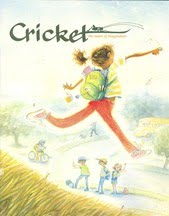Are your characters believable?
Of late, I've been reading lots--and reading about lots--of different children's fiction. Throw in some of adult reading and nonfiction, assigned writing and many imaginary ( and real) protagonists have invaded my mind. While not all are memorable or seem true to their own characterization, many authors succeed in doing both. Often when constructing a fictional character, we borrow bits and pieces from life. But how frequently do you learn something in real life--someone's romantic difficulties or a high-profile heist--and think to yourself, no one would believe this if it were in a novel? When developing my stories, I start down one road, sometimes making a flamboyant character, and question whether the reader will believe in her or in course of events. Sometimes I pare down how I might portray a person or an event thinking that by doing so, the reader will trust my fiction more. By doing so, I often find that my readers think the character less believable. Then I read someone else's fiction--a character in an incredible situation. The author has handled it so deftly, that a reader becomes engrossed...and, for pages and pages, believes. That's what I'm striving for. What about you? When developing your own believable fictional characters, do you stray from your own experiences and embellish elements? Or do you stay close to reality, maybe sticking close to the facts of an event or how people you know would act? "Happy Holidays!" to all the readers of WOW! Women on Writing. Elizabeth King Humphrey is a writer and creativity coach. Besides contributing to AOL's ParentDish, she blogs at The Write Elizabeth, delving into creativity in everyday places.Labels: children's fiction, Elizabeth King Humphrey, fictional characters, staying true to characters
Writing Children's Short Stories Dos and Don'ts Part 2
 It's time for part two of "Writing Short Stories Dos and Don'ts." If you missed part one, you can find it here.Now onto part deux: Don’t use words like “she shouted” or “he exclaimed” or “she questioned” after dialogue. Don’t be afraid to repeat the word “said.” It is the best dialogue tag. Instead of having to use “said” all the time, you can also use action or setting details as dialogue tags. For example:
“When are you going to let me come into your clubhouse?” Martha stood with her nose at the door, trying to peek through a crack in the wood.
Henry sat in the middle of his clubhouse and thought about it for almost a whole second before he said, “Never.”
She stomped her foot and screamed. “I’ll just stand out here and scream until you let me in!”
Before Henry answered her, he put earplugs in his ears. “Okay.” He hummed and went back to carving his statue.
Do use humor in children’s stories. Magazine editors are always looking for humorous stories. They get tons of stories on divorce and other “serious” kid issues. These are important; but if you are a new author, try something that editors always need. (Usually, editors are looking for stories that appeal to boys, too.)
Don’t write a story for a magazine if you have never seen the magazine. Do read back issues or sample stories on a website before you start writing for the magazine. Try to find out what subjects their recent stories have covered and send something different.
Do send seasonal material at least six months in advance. Some magazines want it even further in advance. Also, check websites and magazine guidelines for themes. Brainstorm ideas to fit the themes, and think outside the box.
Don’t give up if you get one or two rejections. Look for new markets—online magazines or children’s newsletters that would be interested in publishing your fiction.
Do use Times New Roman as your font. Also, use 12 pt. font and double-space your fiction stories. Put a heading on each page—page number, your last name, and part of the title.
I hope these few dos and don'ts help everyone on their road to publication success with writing children's short stories!
Happy Writing!
Margo Dill https://margodill.com/blog/
Labels: children writers, children's fiction, Margo Dill, Writing for magazines
Hop, skip and jump to your desk!
For the most part, I make my money writing non-fiction for newspapers, magazines, television, and blogs. But when my kids head back to school (and in between the paying jobs), I'm dusting off my fiction writing, sweeping away some cobwebs and getting back into creating fictional worlds. It's been too long, but in a way it feels natural to have let the stories germinate for a while. But Thursday morning, as the kids head out the door, I'll revel in the silence (for 5 minutes) and then hop, skip and jump for my pen and paper. Recently I read that to keep your writing fluid and fresh it helps to dive into a variety of writing styles, genres and projects. Always admired poetry? Dip into during a quiet lunchtime. Interested in short stories? Pull out a pen and pad while waiting for your laundry to dry or for a friend to come visit. For me, I've been dabbling in non-fiction writing by chance. I was writing fiction--short stories and a couple novels--when I started picking up non-fiction writing assignments. Because of my journalism background, it was a natural fit. But I've now strayed so far that I am aching to finish a novel I've started, a young adult novel my daughter is begging me for, and to stitch together the threads of a story I have been sketching since spring. With the kids returning to school in a couple days, I am anxious to start creating and crafting fiction again. Is there anything you've been wanting to get back into creating? What has been stopping you? What is one small step--or one small hop, skip or jump--you can take to start getting back on the path to your project? Elizabeth King Humphrey is a certified Kaizen-Muse Creativity Coach and freelance writer. She also blogs at www.CoastalCarolinaMoms.com and www.TheWriteElizabeth.com, delving into creativity in everyday places. For different reasons, she--and her children--will be counting the hours until school starts.Labels: advice for writers, children's fiction, fiction
Danette Haworth, author of Violet Raines Almost Got Struck By Lightning, Launches her Blog Tour!
 & Book Giveaway Comments Contest! & Book Giveaway Comments Contest!
In Violet Raines Almost Got Struck By Lightning Danette Haworth tells a story of growing up and making friends--with a few alligators and lightning bolts thrown in for excitement. Violet Raines' life has been just perfect and when things start going wrong she blames Melissa, the new girl in the neighborhood. But maybe it isn't Melissa who causes all the changes, maybe it's Violet. Haworth has been writing and making people laugh since she was six years old. As an Air Force brat, she also is an expert at making new friends. Haworth combined those two experiences to make a funny and poignant book that will seem familiar to every young girl whether she lives in Alaska or Zimbabwe. Finally settled down in Violet's backyard--Florida--Danette would own a diner called "Netti's" if she wasn't a writer. It would be small--you'd probably pass it if you drove by too fast--but the regulars would be loyal. "Try the sweet potato loaf," they'd tell each other. "It is to die for!" We had to include this trailer of Danette's book, made by Scholastic--it's so fun! Check it out.
|













